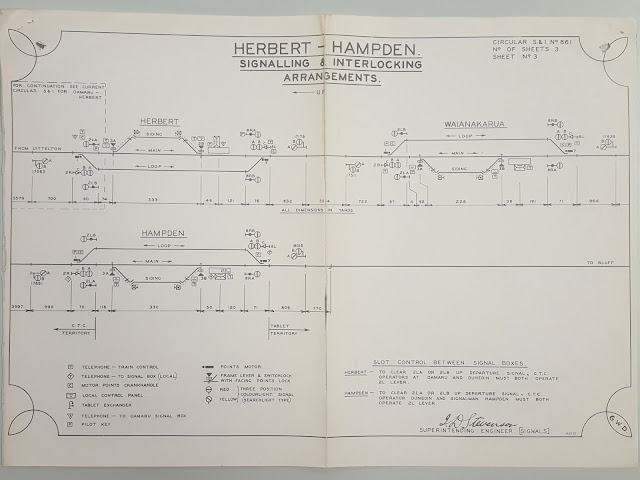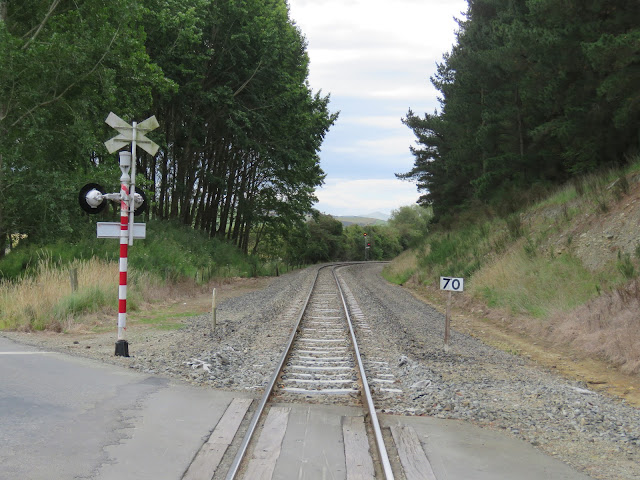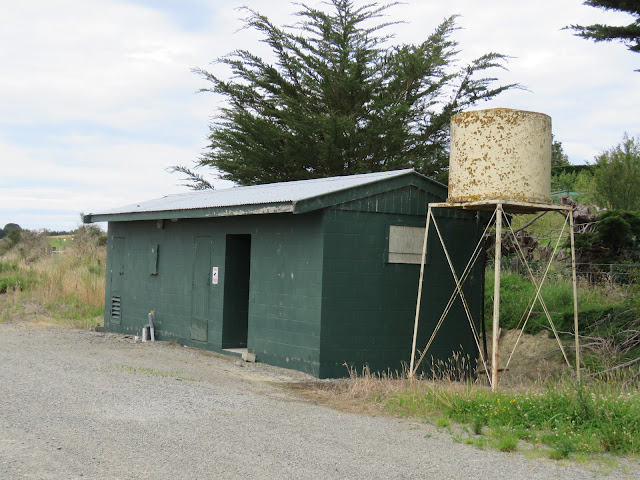For my first station profile I've chosen Herbert, a small blink and you've missed it Otago village on State Highway 1 and more importantly a crossing loop on the South Island Main Trunk.
Opened on the 14th of November 1876, Herbert is located at the 276 kilometer mark on the South Island Main Trunk (SIMT). On the 7th of September 1878 the South Island Main Trunk between Christchurch and Dunedin was finally completed and opened for traffic. The station then settled into its role as a small country crossing station serving Herbert and the surrounding area. As a station operating under tablet train control Herbert was manned with staff operating the tablet machine, assisting with crossings and looking after passengers and inwards and outwards goods traffic.
Like many stations in New Zealand, Herbert consisted of a main line, crossing loop and goods siding. Herbert was similar to other stations between Oamaru and Dunedin along the South Island Main Trunk where the siding come directly off the mainline on the opposite side to the crossing loop. Stations with this layout included Waianakarua, Hampden, and Waikouaiti. This layout was used in these locations so the station, siding and goods shed were all on the side closest to the township they served allowing for safe and easy access.
Herbert - Hampden Signalling and Interlocking Arrangements Diagram. Credit: Archives New Zealand Dunedin.In 1959 Herbert was upgraded as part of the new Centralised Traffic Control (CTC) system introduced to the SIMT. The CTC system between Oamaru and Dunedin was operated from the Train Control Office in Dunedin. With the introduction of CTC the old tablet machine was removed and electric point motors and intermediate, home and departure searchlight signals were installed.
The station was closed to all traffic on the 30th of March 1980.
From 1989 the section between Oamaru and Port Chalmers was converted from CTC to Track Warrant Control (TWC). This system allowed train control to give track warrants to locomotive engineers by radio removing the need for the complex and expensive CTC system. Track Warrants gave Locomotive Engineers permission to proceed from one location to another and provided other information required for the safe working of trains in TWC sections. As part of the conversion a number of stations with short loops were closed while new loops with TWC signals were constructed. Herbert was retained as a crossing loop under the new TWC system but unusually retained its searchlight signals. It was during this time that the goods siding was also removed.
The removal of the goods siding proved short sighted as Herbert was used in the mid 1990's as a loading point for logs from the nearby Herbert Forest. The resident Oamaru DSC shunting locomotive would bring USL log wagons from Oamaru and set them on the main line. While the DSC ran round the train logs stored on the site of the old goods siding would be loaded onto the USL wagons by front end loader. Once loaded the shunt would return to Oamaru where the log wagons would await pick up by a mainline freight train.
Where once any number of goods, express goods and passenger and express trains would keep the tracks shiny, Herbert has approximately eight freight trains pass through every day. The loop is rarely used except for the occasional crossing when a delayed train has been unable to cross its opposite number at its normal place.
To get a better idea of the track and infrastructure through Herbert we'll start from the south at Otepopo Tunnel. Otepopo tunnel is 220 metres long and is tunnel number 2 on the South Island Main Trunk. The first tunnel on the South Island Main Trunk is the Lyttleton Tunnel linking Christchurch with Lyttleton Harbour.
Trains then cross the level crossing at Glencoe Road as they approach the up intermediate double searchlight signal.
Trains then climb a straight section as they approach Herbert.
Between the current southern end of the crossing loop and the Herbert Road level crossing loop was the original Herbert railway station. Like many other stations, this building was demolished in the 1980's.
A northbound freight lead by two Mitsubishi DJ Bo-Bo-Bo diesel electric locomotives pass Herbert station in the late 1970's. Photographer: Joe Wallace
Just to the east of the main line and north of the Herbert Road level crossing is the Herbert signal cabin. This non descript concrete block building contains all the signaling equipment for the Herbert crossing loop and may also contain a stand by generator and toilet.
Heading towards the northern end of the crossing loop is the up main and loop departure signals, the northern crossing loop points and the down home signal.
The main line then crosses the Frew Road level crossing.
Heading north from the Frew Road level crossing we pass the down intermediate signal and then cross the Irvine Road level crossing.
Looking south along the shiny rails of the South Island Main Trunk from the Irvine Road level crossing.
And that's it for my first station profile.
Just a reminder tracks are for trains. All my photos were taken from public land and roads including level crossings.
As this is my first station profile if you like what you've see or have some constructive advice on what I could do better please leave a comment.
And that's about it.























This is a very good article, well done. On the MSL there are still CTC signalled crossing loops today at Sawyers Bay, Waitati, Merton, the loop you mentioned at Herbert and Oamaru. The Waiareka Junction loop might also have been retained with it's CTC signals until the Taylor's Limeworks Branch closed in 1997.
ReplyDeleteI have a couple of questions: was there a CTC signalled crossing loop at Purakaunui back in the day? Also what sort of signalling did Pukeuri Junction have in 1983, just before the Kurow Branch closed?
Thanks for checking out my blog Chris. Purakanui was a CTC signaled crossing loop. Looking at the station diagram there was only a main and a crossing loop there. Not sure if there was ever a goods siding for local freight traffic or if this was handled by roadside van at the station.
DeleteI'm pretty sure that the junction for the Kurow Branch at Pukeuri was controlled by CTC signaling at the time of the branch being closed. Interestingly, branch trackage can still be seen in the road at the railway crossing at the north end of Pukeuri yard next to the freezing works.
Thanks for the info. I'd imagine that the Kurow Branch would have had colour light distant and home signals for trains coming off the branch onto the Main South Line
ReplyDelete